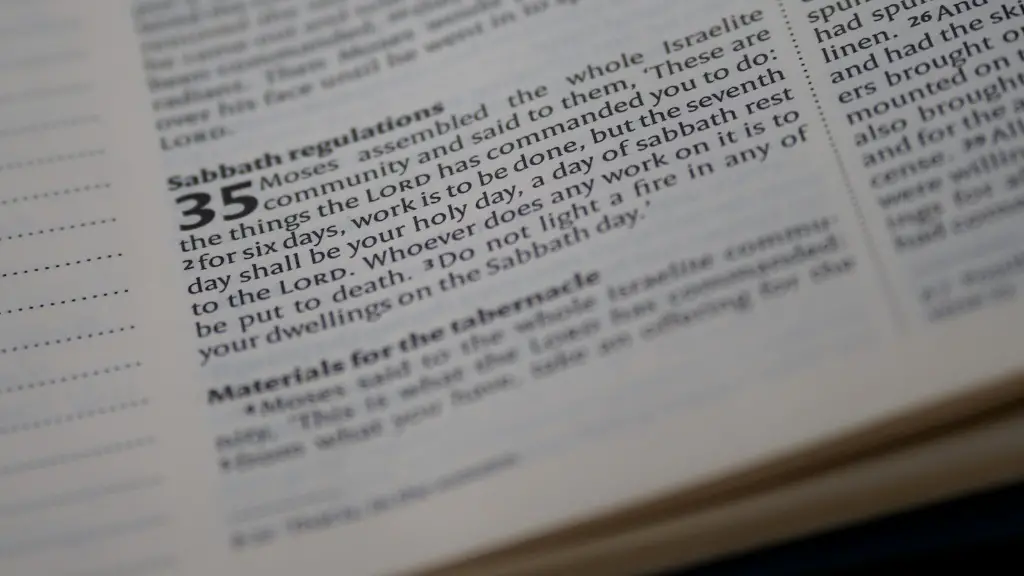The Bible is one of the world’s most important and widely distributed religious books and is divided into two parts: the Old Testament and the New Testament. Written by a variety of people over a period of 1,500 years, the Bible is split into books, chapters and verses and contains a vast number of stories, parables, proverbs, songs and prophecy. Understanding how the Bible is divided is essential for any Bible reader because it gives an overall understanding of the religious texts.
One of the most essential things to know about the structure of the Bible is what books are included in the Old Testament and New Testament: The Old Testament contains 39 books comprising of the Pentateuch – the five books of Moses – and another 34 books, including religious works of historical, poetic and prophetic nature. The New Testament, on the other hand, consists of 27 books, which are mainly composed of accounts from Jesus’s life and teachings.
To make the books easier to read, they are divided further into chapters, which themselves can be broken down into smaller sections known as verses. To help the reader better understand the structure and content of the Bible, the books are broken down into two major categories: Law and History in the Old Testament, and Gospels and Epistles in the New Testament. They are named as such because they provide an explanation of the laws of God and tell a chronological account of the history of the Hebrews, while the Gospel books provide an in-depth look at the life and works of Jesus Christ, and the Epistles contain letters from the apostles to early churches.
To get an even better grasp of the Bible’s contents, it is also important to understand the types of literature used in the various books. Generally, the Old Testament contains the bulk of this varied literature, made up of different genres such as history, law, prophecy, poetry, and song. The New Testament books, however, primarily consist of narrative and discourses. In addition, some of the minor books, such as the books of wisdom and the poems, mainly consist of the poetic and figurative genres.
In terms of language, the Bible was composed in Hebrew, Aramaic and Greek, and has been translated into a large number of languages: approximately 600 modern ones. Various commentaries and spiritual interpretations have also been written alongside the Bible itself, offering further insight into the various books and passages. While some of these are available in print and online, others are sermon-style discourse delivered by religious teachers and clergy.
The Church has also been a major proponent in spreading the knowledge of the Bible by developing various liturgical litanies and services from the book, such as the Mass, the Matins and the Vespers. These are done in order to create a better understanding of the book, its stories and its teachings.
Division Of Old Testament Books
The Old Testament is divided into three major divisions: the Law, the History, and the Writings. The Law consists of the Pentateuch, which consists of the first five books in the Bible—Genesis, Exodus, Leviticus, Numbers, and Deuteronomy. It is the basis of the covenant between God and His people, providing a legal code by which the Israelites are to live. Written by Moses, it is also a collection of stories and religious laws.
The second major section is the History, which consists of eight books and primarily tells of the history of the Israelites from the time of the Exodus from Egypt to the time of the kingship of King Solomon. The eight books of History are Joshua, Judges, Ruth, 1 and 2 Samuel, and 1 and 2 Kings. These books are written in story form and provide an engaging narrative of the nation of Israel.
The third major division is the Writings and includes the Proverbs, Job, Song of Solomon, as well Psalms, Ecclesiastes, and Lamentations. This section of the Bible is not written in narrative form, but rather as poetic, poetic prose and didactic works. They reflect on a person’s relationship with God, the relationship of the people of Israel to God, and the relationship of the individual to his fellow man.
Division Of New Testament Books
The New Testament consists of 27 books, which are divided into four categories: Gospels, history, letters, and prophecy. The four Gospels are written by Matthew, Mark, Luke and John and provide an account of Jesus’ life and teachings in narrative form. The Acts of the Apostles is the fifth book of the New Testament, and is a history of the early Church, from the ascension of Jesus to the time of Paul’s imprisonment.
The Letters are the epistles, or letters, written by the apostles—especially Paul—to churches, individuals and other believers. These are written primarily in the form of instructions about living a Christian life. The last book of the New Testament is the prophetic Revelation of John. In this book, John recounts a vision of a new heaven and a new earth, and uses imagery to describe the end of a cosmic battle between good and evil.
Organization Of The Bible’s Books
The Old Testament is organized into five major divisions that generally parallel the major themes in the books: Law, History, Poetry, Prophecy, and Wisdom. The books are further divided into three categories: the Torah, or Law; the Nevi’im, or Prophets; and the Kethubim, or writings. In the New Testament, the books are divided into the four Gospels; Acts, a history of the Church; the Letters, or epistles; and Revelation, a prophetic vision.
The order of books in both Old and New Testaments is not fixed and is subject to change over time. Many different Christian denominations have their own order of books, and various editions of the Bible can differ in the order of books. For example, the Jewish Bible order is quite different from the Protestant order in the Old Testament.
Sources Used In The Bible
It is important to understand that the Bible is not composed solely of original information, but also includes other sources. In addition to the Old Testament writings and New Testament letters, the books of the Bible incorporate other scriptural works and even secular sources, such as Egyptian chronicles. Other sources used in writing the Bible include oral traditions, hymns, and folktales.
Perhaps the most comprehensive source of information on the composition of the Bible is the Talmud, a collection of Jewish commentaries on the scriptural writings. It provides detailed information on the books, segments and individual verses, as well as their authors and circumstances of composition. It also explains the sources used in making up the Bible, the authority behind its books and the purpose of different passages.
Analysis Of Bible’t Circulation
The Bible is the most widely-circulating book in the world, with well over five billion copies having been printed since the invention of the printing press in the 15th century. Over the years, the Bible has been translated into a vast array of languages, including over 600 modern languages. With a global daily scripture readership estimated to be in the millions, it is certainly the most widely read book worldwide.
Over the years, the Bible has shaped world history in many ways. In particular, it has had a profound effect on the development of Western literature, art, philosophy and even science. In addition, it has provided a moral framework and religious guidance for generations of Christians and Jews, as well as believers from other religions.
Today, the Bible is available in a variety of editions, from recognizable text-based translations to digital and audio versions. Advancements in technology such as multimedia, font-style variations and artwork, have allowed us to appreciate the Bible in new ways and draw a deeper connection to the world’s most renowned religious text.
Historical Significance Of The Bible
Since its first publication, the Bible has been an influential text in world history and a powerful tool of cultural and political power. Over the centuries, its message has been used to shape societies, empower and oppress marginalized groups, inspire brilliant works of literature, challenge and combat injustice, and, of course, teach spiritual truths.
In the modern era, the Bible is still used for political, social and religious purposes. From protests to petitions for legislative reforms, its passages and principles often serve as the guidelines for political actions. Even in the digital age, we are reminded that the Bible still has tremendous influence, as it continues to shape the morals of those who find solace or strength in its words, stories and teachings.
Biblical Literacy In Contemporary Culture
Contemporary culture is somewhat lacking in knowledge of the Bible, with a survey published in 2018 showing that only 47.9 percent of adults in the United States are familiar with the stories and teachings of the Bible. This is significantly lower than previous decades and serves as a wake-up call for educators, religious organizations and individuals alike to prioritize biblical literacy and ensure that the precious knowledge and wisdom contained therein doesn’t get left behind.
In an effort to fill this proverbial knowledge gap, initiatives such as the Bible Literacy Project have taken it upon themselves to provide teachers and students with materials, resources and tools designed to increase biblical literacy. This is an essential step in the right direction, allowing teacher to use engaging materials to teach students about the stories, teachings and interpretations of the Bible in an accessible, enjoyable and non-denominational manner.
Tools And Strategies For Bible Reading
In order to effectively understand the Bible, it is important to be familiar with the various books and how to interpret their content. One important tool that can help deepen the reader’s understanding is the concordance, or index, which helps to find references or verses relating to the original text.
Another important tool is a Bible commentary, which is a guide that usually lays out the overall message and main points of a chapter. Bible commentaries are available in book form, as well as online, and are often written by trusted counselors, theologians and scholars.
Finally, Bible study helps build a deep and lasting understanding of the scriptures. This is because it encourages the reader to explore scriptures from different angles, allowing them to gain a better understanding of the words, meanings and contexts. Bible study tools such as the life application study Bible and the NIV Bible offer the reader insightful comments and teaching that can help to delve deeper into its message.





